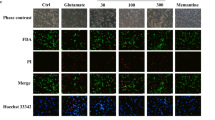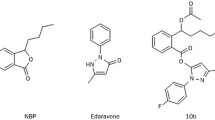Abstract
The pharmacological or toxicological activities of the degradation products of drug candidates have been unaddressed during the drug development process. Ischemic stroke accounts for 80% of all strokes and is responsible for considerable mortality and disability worldwide. Despite decades of research on neuroprotective agents, tissue plasminogen activators (t-PA), a thrombolytic agent, remains the only approved acute stroke pharmacological therapy. NXY-059, a free radical scavenger, exhibited striking neuroprotective properties in preclinical models and met all the criteria established by the Stroke Academic Industry Roundtable (STAIR) for a neuroprotective agent. In phase 3 clinical trials, NXY-059 exhibited significant neuroprotective effects in one trial (SAINT-I), but not in the second (SAINT-II). Some have hypothesized that N-t-butyl hydroxylamine (NtBHA), a breakdown product of NXY-059 was the actual neuroprotective agent in SAINT-I and that changes to the formulation of NXY-059 to prevent its breakdown to NtBHA in SAINT -II was the reason for the lack of efficacy. We evaluated the neuroprotective effect of NtBHA in N-methyl-D-aspartate (NMDA)-treated primary neurons and in rat focal cerebral ischemia. NtBHA significantly attenuated infarct volume in rat transient focal ischemia, and attenuated NMDA-induced cytotoxicity in primary cortical neurons. NtBHA also reduced free radical generation and exhibited mitochondrial protection.




Similar content being viewed by others
References
Bae ON, Majid A (2013) Role of histidine/histamine in carnosine-induced neuroprotection during ischemic brain damage. Brain Res 1527:246–254. https://doi.org/10.1016/j.brainres.2013.07.004
Hacke W, Donnan G, Fieschi C, Kaste M, von Kummer R, Broderick JP, Brott T, Frankel M, Grotta JC, Haley EC Jr, Kwiatkowski T, Levine SR, Lewandowski C, Lu M, Lyden P, Marler JR, Patel S, Tilley BC, Albers G, Bluhmki E, Wilhelm M, Hamilton S, Investigators AT, Investigators ET, Investigators Nr-PSG (2004) Association of outcome with early stroke treatment: pooled analysis of ATLANTIS, ECASS, and NINDS rt-PA stroke trials. Lancet 363:768–774. https://doi.org/10.1016/S0140-6736(04)15692-4
Wang M, Zhang Y, Feng L, Zheng J, Fan S, Liu J, Yang N, Liu Y, Zuo P (2017) Compound porcine cerebroside and ganglioside injection attenuates cerebral ischemia-reperfusion injury in rats by targeting multiple cellular processes. Neuropsychiatr Dis Treat 13:927–935. https://doi.org/10.2147/NDT.S129522
Lees KR, Davalos A, Davis SM, Diener HC, Grotta J, Lyden P, Shuaib A, Ashwood T, Hardemark HG, Wasiewski W, Emeribe U, Zivin JA, Investigators SI (2006) Additional outcomes and subgroup analyses of NXY-059 for acute ischemic stroke in the SAINT I trial. Stroke 37:2970–2978. https://doi.org/10.1161/01.STR.0000249410.91473.44
Muir KW, Lees KR, Ford I, Davis S, Intravenous Magnesium Efficacy in Stroke Study I (2004) Magnesium for acute stroke (Intravenous Magnesium Efficacy in Stroke trial): randomised controlled trial. Lancet 363:439–445. https://doi.org/10.1016/S0140-6736(04)15490-1
Sydserff SG, Borelli AR, Green AR, Cross AJ (2002) Effect of NXY-059 on infarct volume after transient or permanent middle cerebral artery occlusion in the rat; studies on dose, plasma concentration and therapeutic time window. Br J Pharmacol 135:103–112. https://doi.org/10.1038/sj.bjp.0704449
Lees KR, Zivin JA, Ashwood T, Davalos A, Davis SM, Diener HC, Grotta J, Lyden P, Shuaib A, Hardemark HG (2006) Ischemic NXYTTI NXY-059 for acute ischemic stroke. N Engl J Med 354:588–600. https://doi.org/10.1056/NEJMoa052980
Slemmer JE, Shacka JJ, Sweeney MI, Weber JT (2008) Antioxidants and free radical scavengers for the treatment of stroke, traumatic brain injury and aging. Curr Med Chem 15:404–414. https://doi.org/10.2174/092986708783497337
Lees KR, Sharma AK, Barer D, Ford GA, Kostulas V, Cheng YF, Odergren T (2001) Tolerability and pharmacokinetics of the nitrone NXY-059 in patients with acute stroke. Stroke 32:675–680. https://doi.org/10.1161/01.str.32.3.675
Lees KR, Barer D, Ford GA, Hacke W, Kostulas V, Sharma AK, Odergren T, Investigators S-N- (2003) Tolerability of NXY-059 at higher target concentrations in patients with acute stroke. Stroke 34:482–487. https://doi.org/10.1161/01.str.0000053032.14223.81
Bath PM, Gray LJ, Bath AJ, Buchan A, Miyata T, Green AR, Investigators NXYEM-aiIAwS (2009) Effects of NXY-059 in experimental stroke: an individual animal meta-analysis. Br J Pharmacol 157:1157–1171. https://doi.org/10.1111/j.1476-5381.2009.00196.x
Green AR, Ashwood T, Odergren T, Jackson DM (2003) Nitrones as neuroprotective agents in cerebral ischemia, with particular reference to NXY-059. Pharmacol Ther 100:195–214. https://doi.org/10.1016/j.pharmthera.2003.07.003
Macleod MR, van der Worp HB, Sena ES, Howells DW, Dirnagl U, Donnan GA (2008) Evidence for the efficacy of NXY-059 in experimental focal cerebral ischaemia is confounded by study quality. Stroke 39:2824–2829. https://doi.org/10.1161/STROKEAHA.108.515957
Diener HC, Lees KR, Lyden P, Grotta J, Davalos A, Davis SM, Shuaib A, Ashwood T, Wasiewski W, Alderfer V, Hardemark HG, Rodichok L, Saint I, Investigators II (2008) NXY-059 for the treatment of acute stroke: pooled analysis of the SAINT I and II trials. Stroke 39:1751–1758. https://doi.org/10.1161/STROKEAHA.107.503334
Hill MD (2007) Stroke: the dashed hopes of neuroprotection. Lancet Neurol 6:2–3. https://doi.org/10.1016/s1474-4422(06)70658-5
Proctor PH, Tamborello LP (2007) SAINT-I worked, but the neuroprotectant is not NXY-059. Stroke 38:e109; author reply e110. https://doi.org/10.1161/STROKEAHA.107.489161
Kim ES, Kim D, Nyberg S, Poma A, Cecchin D, Jain SA, Kim KA, Shin YJ, Kim EH, Kim M, Baek SH, Kim JK, Doeppner TR, Ali A, Redgrave J, Battaglia G, Majid A, Bae ON (2020) LRP-1 functionalized polymersomes enhance the efficacy of carnosine in experimental stroke. Sci Rep 10:699. https://doi.org/10.1038/s41598-020-57685-5
Baek SH, Noh AR, Kim KA, Akram M, Shin YJ, Kim ES, Yu SW, Majid A, Bae ON (2014) Modulation of mitochondrial function and autophagy mediates carnosine neuroprotection against ischemic brain damage. Stroke 45:2438–2443. https://doi.org/10.1161/STROKEAHA.114.005183
Kim EH, Kim ES, Shin D, Kim D, Choi S, Shin YJ, Kim KA, Noh D, Caglayan AB, Rajanikant GK, Majid A, Bae ON (2021) Carnosine protects against cerebral ischemic injury by inhibiting matrix-metalloproteinases. Int J Mol Sci. https://doi.org/10.3390/ijms22147495
Jain S, Kim ES, Kim D, Burrows D, De Felice M, Kim M, Baek SH, Ali A, Redgrave J, Doeppner TR, Gardner I, Bae ON, Majid A (2020) Comparative cerebroprotective potential of d- and l-carnosine following ischemic stroke in mice. Int J Mol Sci. https://doi.org/10.3390/ijms21093053
Lee H, Park J, Park K (2022) Assessment of agonistic and antagonistic properties of humidifier disinfectants to the estrogenic and androgenic receptors by transactivation assay. Toxicol Res 38:99–109. https://doi.org/10.1007/s43188-021-00111-3
Choi SM, Cho YS, Park G, Lee SK, Chun KS (2021) Celecoxib induces apoptosis through Akt inhibition in 5-fluorouracil-resistant gastric cancer cells. Toxicol Res 37:25–33. https://doi.org/10.1007/s43188-020-00044-3
Kim D, Kim EH, Choi S, Lim KM, Tie L, Majid A, Bae ON (2021) A commonly used biocide 2-N-octyl-4-isothiazolin-3-oneInduces blood-brain barrier dysfunction via cellular thiol modification and mitochondrial damage. Int J Mol Sci. https://doi.org/10.3390/ijms22052563
Kim D, Kim EH, Bae ON (2021) Comparative study of two isothiazolinone biocides, 1,2-benzisothiazolin-3-one (BIT) and 4,5-dichloro-2-n-octyl-isothiazolin-3-one (DCOIT), on barrier function and mitochondrial bioenergetics using murine brain endothelial cell line (bEND.3). J Toxicol Environ Health A 84:932–943. https://doi.org/10.1080/15287394.2021.1955786
Bharate SS (2021) Critical analysis of drug product recalls due to nitrosamine impurities. J Med Chem 64:2923–2936. https://doi.org/10.1021/acs.jmedchem.0c02120
Atamna H, Paler-Martinez A, Ames BN (2000) N-t-butyl hydroxylamine, a hydrolysis product of alpha-phenyl-N-t-butyl nitrone, is more potent in delaying senescence in human lung fibroblasts. J Biol Chem 275:6741–6748. https://doi.org/10.1074/jbc.275.10.6741
Ma S, Yin H, Chen L, Liu H, Zhao M, Zhang X (2012) Neuroprotective effect of ginkgolide K against acute ischemic stroke on middle cerebral ischemia occlusion in rats. J Nat Med 66:25–31. https://doi.org/10.1007/s11418-011-0545-7
Yamato M, Egashira T, Utsumi H (2003) Application of in vivo ESR spectroscopy to measurement of cerebrovascular ROS generation in stroke. Free Radic Biol Med 35:1619–1631. https://doi.org/10.1016/j.freeradbiomed.2003.09.013
Abe K, Tonomura M, Ito M, Takai N, Imamoto N, Rokugawa T, Momosaki S, Fukumoto K, Morimoto K, Inoue O (2015) Imaging of reactive oxygen species in focal ischemic mouse brain using a radical trapping tracer [(3)H]hydromethidine. EJNMMI Res 5:115. https://doi.org/10.1186/s13550-015-0115-1
Terasaki Y, Liu Y, Hayakawa K, Pham LD, Lo EH, Ji X, Arai K (2014) Mechanisms of neurovascular dysfunction in acute ischemic brain. Curr Med Chem 21:2035–2042. https://doi.org/10.2174/0929867321666131228223400
Shen H, Yuan Y, Ding F, Hu N, Liu J, Gu X (2010) Achyranthes bidentata polypeptides confer neuroprotection through inhibition of reactive oxygen species production, Bax expression, and mitochondrial dysfunction induced by overstimulation of N-methyl-D-aspartate receptors. J Neurosci Res 88:669–676. https://doi.org/10.1002/jnr.22221
Chao X, Zhou J, Chen T, Liu W, Dong W, Qu Y, Jiang X, Ji X, Zhen H, Fei Z (2010) Neuroprotective effect of osthole against acute ischemic stroke on middle cerebral ischemia occlusion in rats. Brain Res 1363:206–211. https://doi.org/10.1016/j.brainres.2010.09.052
Margaill I, Plotkine M, Lerouet D (2005) Antioxidant strategies in the treatment of stroke. Free Radic Biol Med 39:429–443. https://doi.org/10.1016/j.freeradbiomed.2005.05.003
Schreibelt G, van Horssen J, van Rossum S, Dijkstra CD, Drukarch B, de Vries HE (2007) Therapeutic potential and biological role of endogenous antioxidant enzymes in multiple sclerosis pathology. Brain Res Rev 56:322–330. https://doi.org/10.1016/j.brainresrev.2007.07.005
Sugawara T, Chan PH (2003) Reactive oxygen radicals and pathogenesis of neuronal death after cerebral ischemia. Antioxid Redox Signal 5:597–607. https://doi.org/10.1089/152308603770310266
Yang S, Li W (2016) Targeting oxidative stress for the treatment of ischemic stroke: Upstream and downstream therapeutic strategies. Brain Circulation 2:153. https://doi.org/10.4103/2394-8108.195279
Saeed SA, Shad KF, Saleem T, Javed F, Khan MU (2007) Some new prospects in the understanding of the molecular basis of the pathogenesis of stroke. Exp Brain Res 182:1–10. https://doi.org/10.1007/s00221-007-1050-9
Chamulitrat W, Jordan SJ, Mason RP, Saito K, Cutler RG (1993) Nitric oxide formation during light-induced decomposition of phenyl N-tert-butylnitrone. J Biol Chem 268:11520–11527. https://doi.org/10.1016/S0021-9258(19)50231-9
Zhao Z, Zhang X, Zhao C, Choi J, Shi J, Song K, Turk J, Ma ZA (2010) Protection of pancreatic beta-cells by group VIA phospholipase A(2)-mediated repair of mitochondrial membrane peroxidation. Endocrinology 151:3038–3048. https://doi.org/10.1210/en.2010-0016
Lee JH, Tak JK, Park KM, Park JW (2007) N-t-Butyl hydroxylamine regulates ionizing radiation-induced apoptosis in U937 cells. Biochimie 89:1509–1516. https://doi.org/10.1016/j.biochi.2007.07.010
Kim HJ, Shin SW, Oh CJ, Lee MH, Yang CH, Park JW (2005) N-t-Butyl hydroxylamine regulates heat shock-induced apoptosis in U937 cells. Redox Rep 10:287–293. https://doi.org/10.1179/135100005X83662
Atamna H, Robinson C, Ingersoll R, Elliott H, Ames BN (2001) N-t-Butyl hydroxylamine is an antioxidant that reverses age-related changes in mitochondria in vivo and in vitro. FASEB J 15:2196–2204. https://doi.org/10.1096/fj.01-0134com
Acknowledgements
This work was supported by a grant from the Ministry of Health and Welfare of Korea (HI14C2180) and grants from the National Research Foundation of Korea, supported by the Ministry of Science, ICT & Future Planning (NRF-2017R1C1B3002626). A.M. was partially supported/funded by the NIHR Sheffield Biomedical Research Centre (BRC). The views expressed are those of the author(s) and not necessarily those of the NHS, the NIHR, or the Department of Health and Social Care (DHSC).
Funding
This study was funded by Ministry of Health and Welfare (Grant number HI14C2180)and National Research Foundation of Korea (Grant number 2017R1C1B3002626).
Author information
Authors and Affiliations
Corresponding authors
Ethics declarations
Conflict of interest
The authors declare no conflict of interests or competing interests.
Additional information
Publisher’s note
Springer Nature remains neutral with regard to jurisdictional claims in published maps and institutional affiliations.
Rights and permissions
About this article
Cite this article
Kim, ES., Shin, Y., Kim, EH. et al. Neuroprotective efficacy of N-t-butylhydroxylamine (NtBHA) in transient focal ischemia in rats. Toxicol Res. 38, 479–486 (2022). https://doi.org/10.1007/s43188-022-00131-7
Received:
Revised:
Accepted:
Published:
Issue Date:
DOI: https://doi.org/10.1007/s43188-022-00131-7




